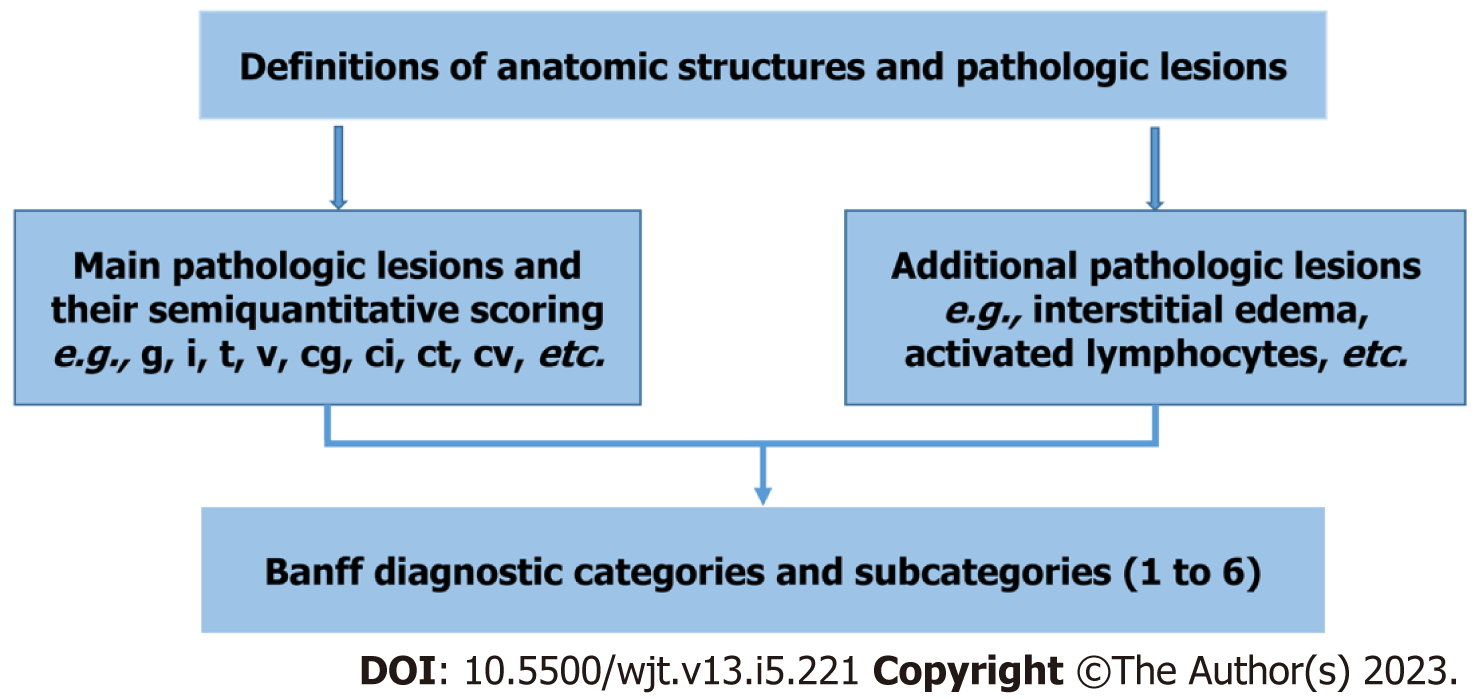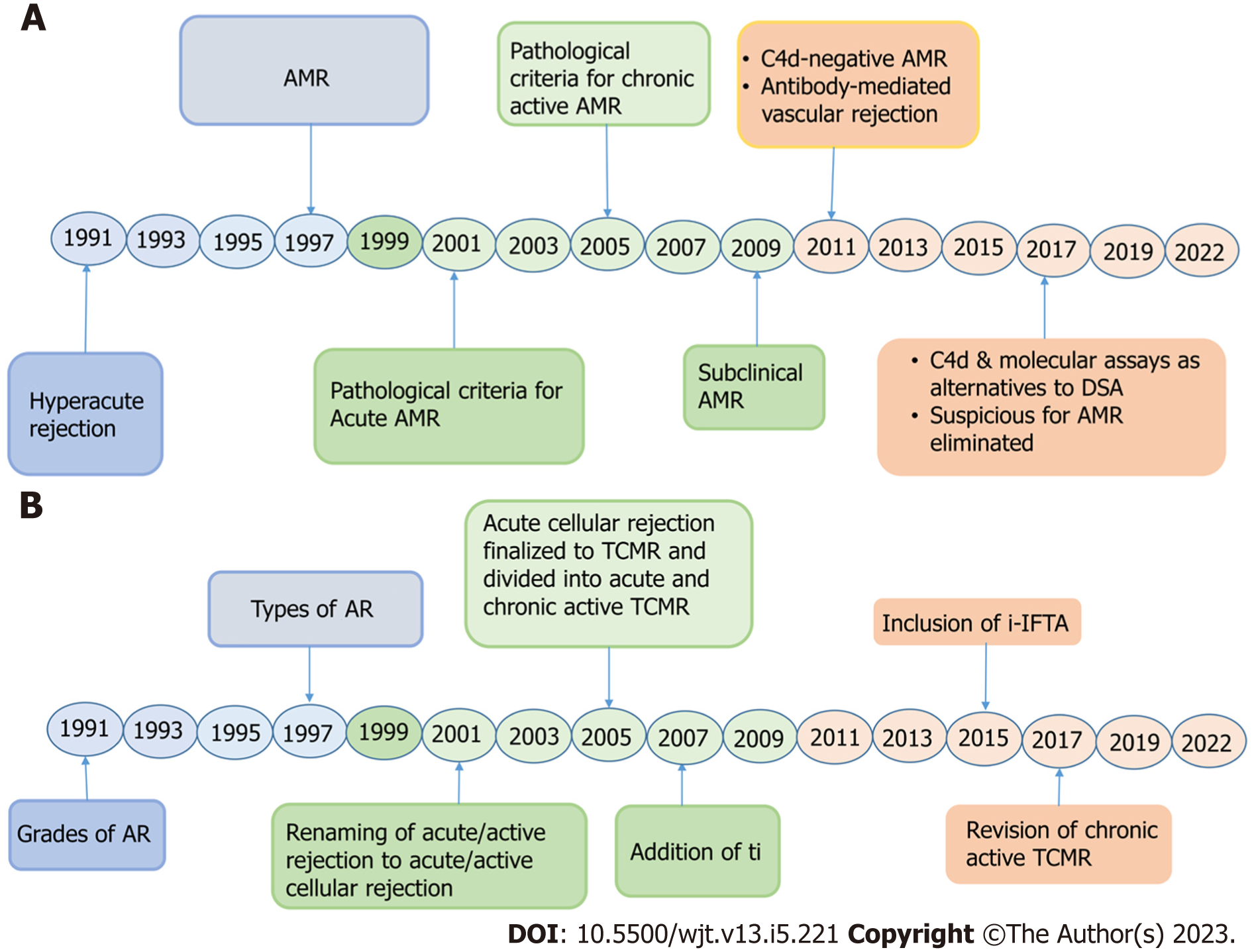Copyright
©The Author(s) 2023.
World J Transplant. Sep 18, 2023; 13(5): 221-238
Published online Sep 18, 2023. doi: 10.5500/wjt.v13.i5.221
Published online Sep 18, 2023. doi: 10.5500/wjt.v13.i5.221
Figure 1 Basic components and construct of the Banff classification system.
The content of the Banff classification can be cataloged into definitions, pathologic lesions, their semi-quantitative scoring, and a combination of these lesions to construct the diagnostic categories.
Figure 2 Representative acute Banff diagnostic lesions for rejection and their scores.
A: There is diffuse interstitial inflammation (i3) along with interstitial edema. The later lesion, although important when present, is not formally included in the Banff classification system. Foci of mild tubulitis (t1) are also seen (arrows). These are better visualized on Period acid-Schiff stain [hematoxylin and eosin (H&E), × 200]; B: This field shows glomerulitis (g1) (black arrow) and intimal arteritis (v1) (orange arrow) in addition to i3 and interstitial edema. Such findings raise the suspicion of mixed antibody-mediated and T cell-mediated rejection (H&E, × 200).
Figure 3 Acute Banff diagnostic lesions of microvascular inflammation.
A: There is segmental glomerulitis (g1) (arrows) along with diffuse interstitial inflammation (i3) in the background [hematoxylin and eosin (H&E), × 400]; B: Peritubular capillaritis (ptc) score ptc 2 (black arrow). ptc is one of the key lesions of antibody-mediated rejection. Patchy interstitial edema, and inflammation with a few plasma cells (orange arrows) are seen in the background (H&E, × 400).
Figure 4 Diagnostic lesions.
A: Acute Banff lesion of glomerulitis. There is segmental glomerulitis (g1) (arrows) characterized by mononuclear inflammatory cell infiltration and endothelial cell enlargement resulting in partial to complete occlusion of capillary lumena. Glomerulitis is one of the key lesions of antibody-mediated rejection. (Period acid-Schiff, ×400); B Morphologic features of mixed antibody-mediated and T cell-mediated rejection with both acute and chronic lesions. There is almost global glomerulitis (yellow arrows) with segmental foci of glomerular basement membrane thickening (blue arrows) suggestive of early transplant glomerulopathy along with diffuse interstitial inflammation (i3) (orange arrows) and peritubular capillaritis (black arrows). An artery included shows severe intimal fibrous thickening (neo-intima formation) without duplication of elastica, (Period acid-Schiff, × 200); C: Mixed acute and chronic Banff diagnostic lesions of rejection. There is segmental glomerulitis (black arrow), peritubular capillaritis (orange arrows), and foci of tubulitis in mildly to moderately atrophic tubules within the scarred cortex (yellow arrows) (Jones Methenamine Silver, × 400).
Figure 5 Diagram depicting the main changes with the timeline.
A: In the category of antibody-mediated rejection (AMR); B: In the category of T cell-mediated rejection (TCMR). DSA: Donor-specific antibody; i-IFTA: Inflammation in the scarred cortex.
- Citation: Mubarak M, Raza A, Rashid R, Shakeel S. Evolution of human kidney allograft pathology diagnostics through 30 years of the Banff classification process. World J Transplant 2023; 13(5): 221-238
- URL: https://www.wjgnet.com/2220-3230/full/v13/i5/221.htm
- DOI: https://dx.doi.org/10.5500/wjt.v13.i5.221













